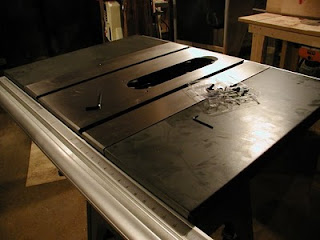 In bits and pieces, I'm still working on assembling my Ridgid R4512 table saw. I’d say I’m about 3 hours or so into it now, and it’s going well. I haven’t had any problems or run into any damaged parts. I’ve been impressed with the instructions, the hardware and the fit and finish of the parts. There are no sharp edges or burrs anywhere.
In bits and pieces, I'm still working on assembling my Ridgid R4512 table saw. I’d say I’m about 3 hours or so into it now, and it’s going well. I haven’t had any problems or run into any damaged parts. I’ve been impressed with the instructions, the hardware and the fit and finish of the parts. There are no sharp edges or burrs anywhere. While the instructions recommend attaching the wings to the table while the table is still upside down, I chose not to go that route because I still had to lug the saw down some narrow stairs to my basement. It wasn’t difficult at all to install the wings myself with the saw rightside up. I managed to hold a wing in place until I got one bolt in, then it wasn’t a problem to support it as I attached the other two bolts. Since the wings are stamped steel, they aren’t perfectly flat. But once you have all the bolts installed, making the wings flush to the top as you go along, they are pretty darn close. I started by finger-tightening all three bolts on one side so the wing would be supported, then gently tapping the wing up or down and tightening the bolt when I was happy with it. I tested for flatness as I went along with the ruler of my combination square then used a jointed board to test for broader flatness. I also slid the board from the cast iron top over the joint of the wing to make sure there weren’t any high spots that would cause deflection. I also knew that if the outside edges of the wings were too high or low, they could be adjusted when I installed the front and back rails that the fence travels on. I’m very satisfied with how flat I was able to make the top and wings.
The next task was to install the front and back rails. These are a little tricky because the nuts you have to fasten are underneath and behind the rails. It isn’t that big of a deal but it was a little more time-consuming than I thought it would be. Each rail is made of two pieces, and since I’ve got so little space, I was hoping to be able to get away with only using one each on the front and back so they would protrude so far to the right. I predict that I will rarely cut anything that far to the right anyway. But because of the way the holes are drilled, you really have to install them as recommended. That’s one suggestion I would make for Ridgid to consider: give the option of only having the rails cover the length of the top and wings. The extra length gives you the option of adding a router table, and I may well do that so that I can get rid of my stand-alone router table. At one point I had to move the saw a bit because of the length of the rails. The lift mechanism was easy to engage. Once the wheels are down, it feels like this huge saw is floating! But when release the lift, the saw falls straight down with a thump. My wife heard it all the way at the front of the house.
The next steps will be installing the blade, blade guard and safety pawls. After that it is just a matter of doing the finishing touches. Then I’ll be able to actually turn the thing on and give it a go! As always, please let me know if you have specific questions about the saw and I will do my best to answer them.







